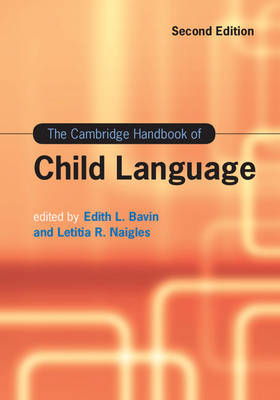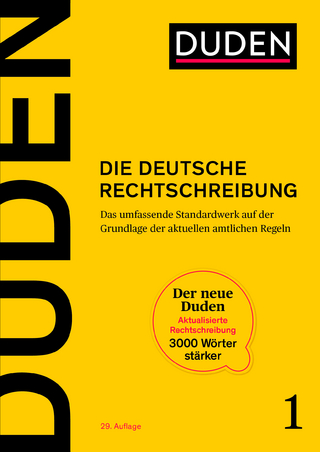
The Cambridge Handbook of Child Language
Cambridge University Press (Verlag)
978-1-107-08732-3 (ISBN)
The most authoritative resource for students and researchers, The Cambridge Handbook of Child Language has been thoroughly updated and extended. Enhancements include new chapters on the acquisition of words, processing deficits in children with specific language impairments, and language in children with Williams syndrome, new authors for the bilingualism and autism chapters, a refocused discourse chapter on written narratives, and a new section on reading and reading disorders, cementing the handbook's position as the best study of the subject available. In a wide-ranging survey, language development is traced from prelinguistic infancy to adolescence in typical and atypical contexts; the material is intuitively grouped into six thematic sections, enabling readers to easily find specific in-depth information. With topics as varied as statistical learning, bilingualism, and the neurobiology of reading disorders, this multidisciplinary Handbook is an essential reference for students and researchers in linguistics, psychology, cognitive science, speech pathology, education and anthropology.
Edith L. Bavin is Professor in the School of Psychological Science at La Trobe University, Australia. Letitia R. Naigles is Professor in Psychology at the University of Connecticut.
List of figures; List of tables; List of contributors; Acknowledgements; 1. Introduction: perspectives on child language Letitia R. Naigles and Edith L. Bavin; Part I. Theoretical and Methodological Approaches: 2. Innateness and learnability Virginia Valian; 3. Statistical learning Erik Thiessen and Lucy Erickson; 4. Neurocognition of language development Angela D. Friederici and Michael A. Skeide; 5. The usage-based theory of language acquisition Michael Tomasello; 6. Crosslinguistic approaches to language acquisition Sabine Stoll; Part II. Early Developments: 7. Speech perception Suzanne Curtin and Stephanie Archer; 8. Crosslinguistic perspectives on segmentation and categorization in early language acquisition Barbara Höhle; 9. From gesture to word Susan Goldin-Meadow; Part III. Phonology, Morphology and Syntax: 10. Babbling and words: a dynamic systems perspective on phonological development Marilyn M. Vihman, Rory A. DePaolis and Tamar Keren-Portnoy; 11. The acquisition of prosodic phonology and morphology Katherine Demuth; 12. The acquisition of grammatical categories Heike Behrens; 13. Verb argument structure Shanley E. M. Allen; 14. The first language acquisition of complex sentences Barbara Lust, Claire Foley and Cristina D. Dye; 15. The morphosyntax interface Kamil Ud Deen; Part IV. Semantics, Pragmatics and Discourse: 16. Lexical meaning Eve V. Clark; 17. The acquisition of words Susan A. Graham, Valerie San Juan and Ena Vukatana; 18. Sentence scope Stephen Crain; 19. Sentence processing Jesse Snedeker and Yi Ting Huang; 20. Pragmatic development Judith Becker Bryant; 21. Language development beyond the sentence Ruth Berman; Part V. Varieties of Development: 22. Language development in bilingual children Erika Hoff; 23. Sign language acquisition studies Diane Lillo-Martin; 24. Children with specific language impairment (SLI) J. Bruce Tomblin; 25. Language symptoms and their possible sources of specific language impairment Laurence B. Leonard; 26. Processing deficits in children with language impairments Lisa M. D. Archibald and Nicolette B. Noonan; 27. Language development in genetic disorders Fiona M. Richardson and Michael S. C. Thomas; 28. Language development in children with Williams syndrome: genes, modularity, and the importance of development Shevaun Lewis and Barbara Landau; 29. Language in children with autism spectrum disorders Letitia Naigles and Iris Chin; Part VI. Reading: 30. Precursors to reading: phonological awareness and letter knowledge Eva Marinus and Anne Castles; 31. Reading disorders Fiona J. Duff and Margaret J. Snowling; 32. Predictors of reading skills across languages Heikki Lyytinen, Hua Shu and Ulla Richardson; 33. Neurobiology of reading disorders: implications of functional neuroimaging studies in dyslexia and specific reading comprehension deficits Katherine Swett, Stephen Bailey, Angela Sefcik and Laurie Cutting; 34. The development of reading comprehension skill: processing and memory Julie A. Van Dyke and Nicole Landi; References; Index.
| Erscheint lt. Verlag | 26.11.2015 |
|---|---|
| Reihe/Serie | Cambridge Handbooks in Language and Linguistics |
| Zusatzinfo | 11 Tables, black and white; 20 Halftones, unspecified; 9 Line drawings, unspecified |
| Verlagsort | Cambridge |
| Sprache | englisch |
| Maße | 185 x 254 mm |
| Gewicht | 2160 g |
| Themenwelt | Geisteswissenschaften ► Sprach- / Literaturwissenschaft ► Sprachwissenschaft |
| ISBN-10 | 1-107-08732-5 / 1107087325 |
| ISBN-13 | 978-1-107-08732-3 / 9781107087323 |
| Zustand | Neuware |
| Informationen gemäß Produktsicherheitsverordnung (GPSR) | |
| Haben Sie eine Frage zum Produkt? |
aus dem Bereich


